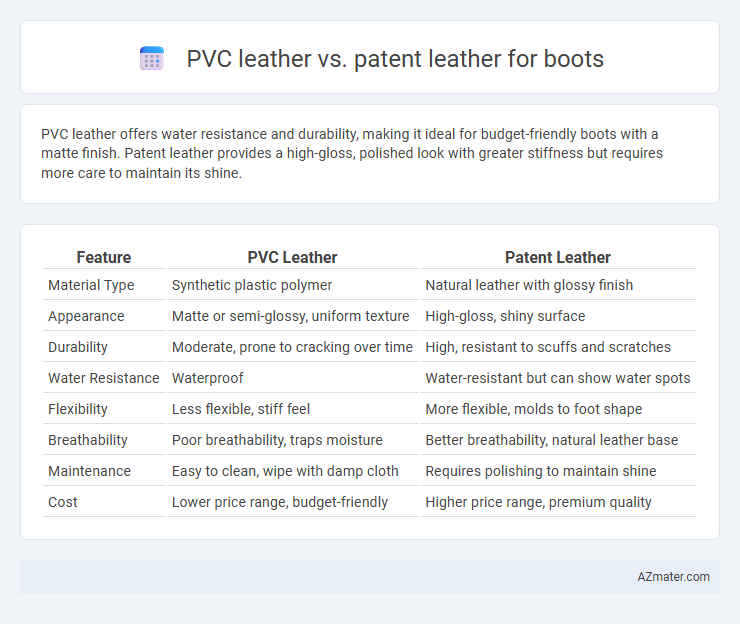PVC leather offers water resistance and durability, making it ideal for budget-friendly boots with a matte finish. Patent leather provides a high-gloss, polished look with greater stiffness but requires more care to maintain its shine.
Table of Comparison
| Feature | PVC Leather | Patent Leather |
|---|---|---|
| Material Type | Synthetic plastic polymer | Natural leather with glossy finish |
| Appearance | Matte or semi-glossy, uniform texture | High-gloss, shiny surface |
| Durability | Moderate, prone to cracking over time | High, resistant to scuffs and scratches |
| Water Resistance | Waterproof | Water-resistant but can show water spots |
| Flexibility | Less flexible, stiff feel | More flexible, molds to foot shape |
| Breathability | Poor breathability, traps moisture | Better breathability, natural leather base |
| Maintenance | Easy to clean, wipe with damp cloth | Requires polishing to maintain shine |
| Cost | Lower price range, budget-friendly | Higher price range, premium quality |
Introduction to PVC Leather and Patent Leather
PVC leather, a synthetic material made from polyvinyl chloride, offers durability, water resistance, and affordability, making it a popular choice for boots. Patent leather, created by applying a high-gloss coating to genuine leather, is known for its shiny finish and elegant appearance, often used in formal footwear. Both materials provide distinct aesthetic and functional benefits, influencing the overall style and maintenance of boots.
Material Composition and Manufacturing Process
PVC leather, also known as synthetic leather, is made from a fabric base coated with polyvinyl chloride, resulting in a durable and water-resistant material commonly used in boots. Patent leather is crafted from genuine animal hide coated with a high-gloss lacquer or plastic finish, giving it a distinctive shiny appearance and a smooth surface. The manufacturing process for PVC leather involves bonding synthetic layers with plasticizers and pigments, while patent leather requires tanning and polishing techniques to achieve its glossy, reflective finish.
Appearance and Texture Differences
PVC leather boots showcase a matte or slightly glossy finish with a uniform texture that mimics genuine leather, offering durability and water resistance. Patent leather boots have a high-gloss, mirror-like shine and a smooth, slick surface that emphasizes sophistication and elegance. The texture of PVC leather feels more flexible and synthetic, while patent leather is stiffer with a polished, almost plastic-like tactile experience.
Durability and Longevity Comparison
PVC leather offers excellent durability due to its water-resistant and scratch-resistant properties, making it ideal for boots exposed to harsh weather conditions. Patent leather, with its glossy finish, is less resistant to scuffs and requires more maintenance to retain its appearance over time. For longevity, PVC leather often outperforms patent leather as it resists cracking and fading, ensuring boots maintain their structural integrity and aesthetic appeal longer.
Water and Stain Resistance
PVC leather offers superior water resistance compared to patent leather due to its synthetic, non-porous surface that repels moisture effectively, making it ideal for wet conditions. Patent leather, while glossy and stylish, is more susceptible to stains and water damage because its natural leather base can absorb liquids if not properly coated. Both materials benefit from regular maintenance, but PVC leather generally provides longer-lasting protection against water and stains for boots.
Comfort and Breathability
PVC leather lacks breathability and tends to retain heat and moisture, leading to discomfort during prolonged wear. Patent leather, made from natural leather coated with a glossy finish, offers slightly better breathability but can still trap heat due to its sealed surface. For boots prioritizing comfort and breathability, natural or untreated leather materials outperform both PVC and patent leather options.
Environmental Impact and Sustainability
PVC leather boots have a higher environmental impact due to their reliance on non-biodegradable synthetic polymers derived from fossil fuels and the release of toxic chemicals during production. Patent leather boots, made from natural leather coated with a glossy finish, involve animal agriculture, which contributes to greenhouse gas emissions and deforestation but generally have better biodegradability compared to PVC alternatives. Choosing sustainably sourced patent leather with eco-friendly tanning processes offers a more environmentally responsible option than PVC leather.
Cost and Affordability
PVC leather boots offer a highly affordable alternative to patent leather, with production costs significantly lower due to synthetic materials and easier manufacturing processes. Patent leather boots involve higher expenses because of the natural leather base and specialized glazing techniques that create their distinctive glossy finish. For consumers prioritizing budget-friendly options without compromising style, PVC leather provides a cost-effective choice, while patent leather remains a premium option with greater durability and luxury appeal.
Maintenance and Care Tips
PVC leather boots require regular cleaning with a damp cloth and mild soap to maintain their synthetic finish and prevent cracking, while avoiding harsh chemicals that can damage the material. Patent leather boots need gentle wiping with a soft cloth and can benefit from occasional application of special patent leather cleaners and conditioners to preserve their glossy surface and prevent scuff marks. Both materials should be stored away from direct sunlight and heat sources to avoid fading and deformation, ensuring long-lasting durability and appearance.
Choosing the Right Leather for Your Boots
PVC leather offers durability and water resistance, making it ideal for boots exposed to harsh weather or frequent wear. Patent leather provides a sleek, glossy finish perfect for formal boots but requires more care to maintain its shine and avoid cracking. Selecting the right leather depends on your need for practicality versus style, with PVC leather suited for rugged use and patent leather best for polished, fashionable appearances.

Infographic: PVC leather vs Patent leather for Boot
 azmater.com
azmater.com